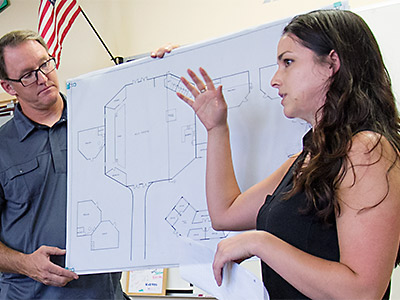
Architecture student Victoria Reyes presents her work at a community-centered project in partnership with High Desert Montessori School. Student Jim Severt assists, holding Reyes' drawing panels.
Truckee Meadows Community College has a longstanding and strong history in Nevada’s architecture community, with its students participating in local, state, and national architecture meetings and competitions.
“We’ve continued to maintain a great program over the years, following in the excellent tradition of Ric Licata and continuing a good reputation in the community,” said Kreg Mebust, Architecture Instructor.
The state board that licenses residential and architecture professionals has given TMCC an even more ambitious charge.
In August, the Nevada State Board of Architecture, Interior Design and Residential Design reviewed the Residential Design Emphasis degree. After careful review of the accreditation process, learning measures and outcomes, and relevant student work examples, the board members were unanimous in support and approval of the program as satisfying NSBAIDRD's two-year education requirement towards eligibility as a residential designer, Mebust added.
TMCC's AAS degree program was recognized by the Board as an equivalent course of study without an approved architectural association or accrediting body membership for the institution. Because the program is an associate of applied science with a 60-credit total, it is equivalent to two years credit from an approved educational program's curriculum. Students that complete the AAS degree will still be required to have a total of five years of combined educational and work-related experience in order to meet the testing qualifications and become licensed as a Residential Designer in Nevada.
The Difference Between Residential Designer and Architect
Residential design programs differ in scope from the more inclusive architecture degrees—an architect plans and designs both commercial and residential buildings, including apartments, stores, factories and hotels. Residential designers create designs for housing with no more than four units per structure, and limited to two stories not including a basement.
Now that other Nevada System of Higher Education institutions have dropped their residential design programs, TMCC is the only public institution offering an associate of applied science degree in residential design.
NSBAIDRD has acknowledged that TMCC would become a robust hub for residential design.
“The State Board supports what we’re doing—they’ve reviewed our course descriptions, curriculum, objectives, assessments and student projects,” Mebust said. “They approved the comprehensiveness of what our program covers. The coursework is well within its standard of practice with what those in the professional community demand from a program of study.”
Process and Procedure
Each occupational program at TMCC is typically set up to include the regular guidance of an advisory board comprising regional professionals. They provide emerging industry knowledge on current, upcoming and evolving practices within their area of focus.
“At our November meeting with the TMCC Construction and Design Advisory Board—a panel of working architects in the community—we'll be sharing the news of the State Board's support for our program,” Mebust said.
The NSBAIDRD will work with TMCC, progressing through a review process every three years.
“Uniquely, the residential design associate program is TMCC's only terminal degree, meaning the student would be able to establish a record with the State Board as fulfilling the educational part of their requirements, and would be able to go to work for an architect as a residential designer,” he said.
Additional Options for Students
Students planning to become residential designers may combine their Associate of Applied Science—Construction and Design, Residential Design Emphasis degree with one of the paths for practical experience prescribed by the State Board, and enter the workforce.
On the other hand, if a student desires to become an architect—having the ability to work on both commercial and residential structures—they typically enroll in an architecture transfer degree program and then complete their four- to five-year bachelor’s degree, before sitting for a rigorous set of multiple examinations.
The University of Nevada, Las Vegas offers a Bachelor of Science in Architecture. It also offers a Master of Architecture (M. Arch.) that is accredited by the National Architectural Accrediting Board (NAAB®).
At TMCC, students may also pursue a Construction and Design Associate of Applied Science Degree, Landscape Architecture Emphasis.
For more information about studying Construction and Design at TMCC, please contact the Architecture Department at 775-673-7265.






